warning YAMAHA YZF-R1 2000 Owner's Guide
[x] Cancel search | Manufacturer: YAMAHA, Model Year: 2000, Model line: YZF-R1, Model: YAMAHA YZF-R1 2000Pages: 115, PDF Size: 12.28 MB
Page 84 of 115
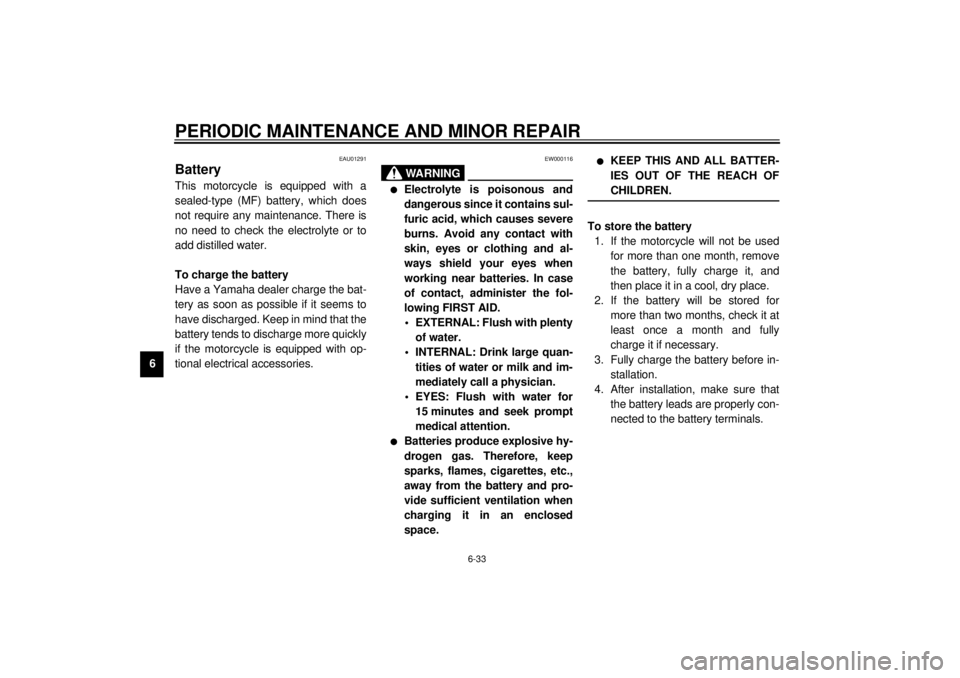
PERIODIC MAINTENANCE AND MINOR REPAIR
6-33
6
EAU01291
Battery This motorcycle is equipped with a
sealed-type (MF) battery, which does
not require any maintenance. There is
no need to check the electrolyte or to
add distilled water.
To charge the battery
Have a Yamaha dealer charge the bat-
tery as soon as possible if it seems to
have discharged. Keep in mind that the
battery tends to discharge more quickly
if the motorcycle is equipped with op-
tional electrical accessories.
EW000116
WARNING
@ l
Electrolyte is poisonous and
dangerous since it contains sul-
furic acid, which causes severe
burns. Avoid any contact with
skin, eyes or clothing and al-
ways shield your eyes when
working near batteries. In case
of contact, administer the fol-
lowing FIRST AID.
• EXTERNAL: Flush with plenty
of water.
• INTERNAL: Drink large quan-
tities of water or milk and im-
mediately call a physician.
• EYES: Flush with water for
15 minutes and seek prompt
medical attention.
l
Batteries produce explosive hy-
drogen gas. Therefore, keep
sparks, flames, cigarettes, etc.,
away from the battery and pro-
vide sufficient ventilation when
charging it in an enclosed
space.
l
KEEP THIS AND ALL BATTER-
IES OUT OF THE REACH OF
CHILDREN.
@To store the battery
1. If the motorcycle will not be used
for more than one month, remove
the battery, fully charge it, and
then place it in a cool, dry place.
2. If the battery will be stored for
more than two months, check it at
least once a month and fully
charge it if necessary.
3. Fully charge the battery before in-
stallation.
4. After installation, make sure that
the battery leads are properly con-
nected to the battery terminals.
E_5jj_Periodic.fm Page 33 Wednesday, February 2, 2000 5:18 PM
Page 87 of 115
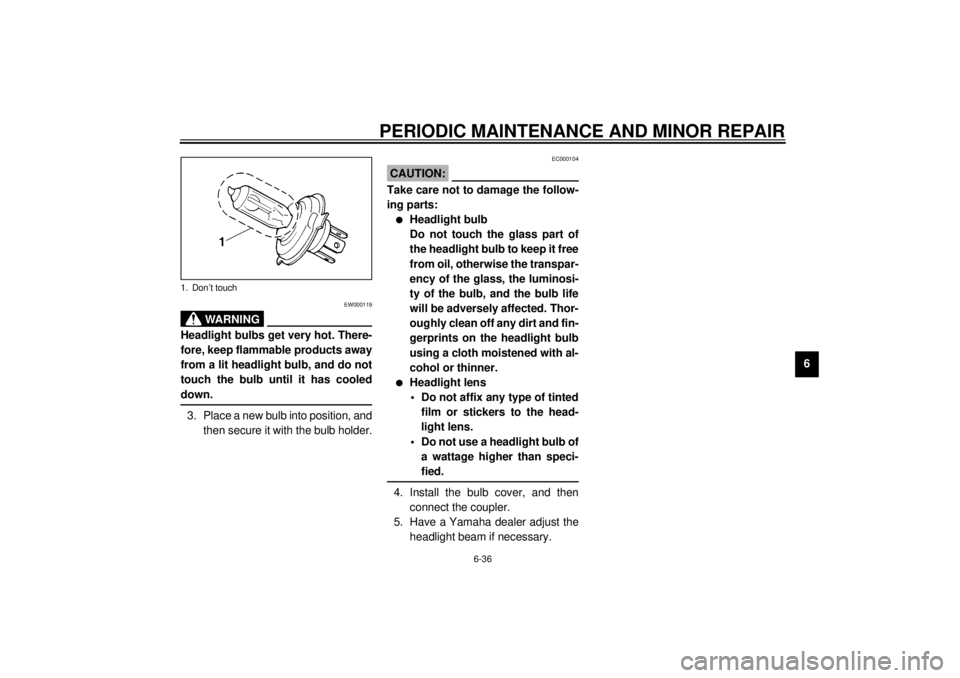
PERIODIC MAINTENANCE AND MINOR REPAIR
6-36
6
EW000119
WARNING
@ Headlight bulbs get very hot. There-
fore, keep flammable products away
from a lit headlight bulb, and do not
touch the bulb until it has cooled
down. @3. Place a new bulb into position, and
then secure it with the bulb holder.
EC000104
CAUTION:@ Take care not to damage the follow-
ing parts:l
Headlight bulb
Do not touch the glass part of
the headlight bulb to keep it free
from oil, otherwise the transpar-
ency of the glass, the luminosi-
ty of the bulb, and the bulb life
will be adversely affected. Thor-
oughly clean off any dirt and fin-
gerprints on the headlight bulb
using a cloth moistened with al-
cohol or thinner.
l
Headlight lens
• Do not affix any type of tinted
film or stickers to the head-
light lens.
• Do not use a headlight bulb of
a wattage higher than speci-
fied.
@4. Install the bulb cover, and then
connect the coupler.
5. Have a Yamaha dealer adjust the
headlight beam if necessary.
1. Don’t touch
E_5jj_Periodic.fm Page 36 Wednesday, February 2, 2000 5:18 PM
Page 90 of 115
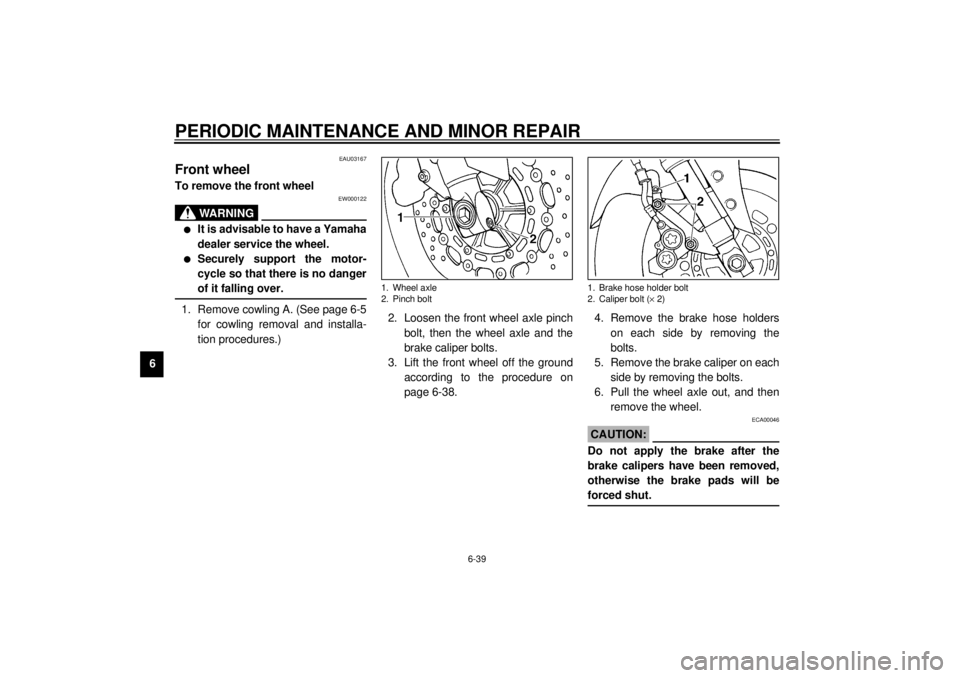
PERIODIC MAINTENANCE AND MINOR REPAIR
6-39
6
EAU03167
Front wheelTo remove the front wheel
EW000122
WARNING
@ l
It is advisable to have a Yamaha
dealer service the wheel.
l
Securely support the motor-
cycle so that there is no danger
of it falling over.
@1. Remove cowling A. (See page 6-5
for cowling removal and installa-
tion procedures.)2. Loosen the front wheel axle pinch
bolt, then the wheel axle and the
brake caliper bolts.
3. Lift the front wheel off the ground
according to the procedure on
page 6-38.4. Remove the brake hose holders
on each side by removing the
bolts.
5. Remove the brake caliper on each
side by removing the bolts.
6. Pull the wheel axle out, and then
remove the wheel.
ECA00046
CAUTION:@ Do not apply the brake after the
brake calipers have been removed,
otherwise the brake pads will be
forced shut. @
1. Wheel axle
2. Pinch bolt
1. Brake hose holder bolt
2. Caliper bolt (´ 2)
E_5jj_Periodic.fm Page 39 Wednesday, February 2, 2000 5:18 PM
Page 92 of 115
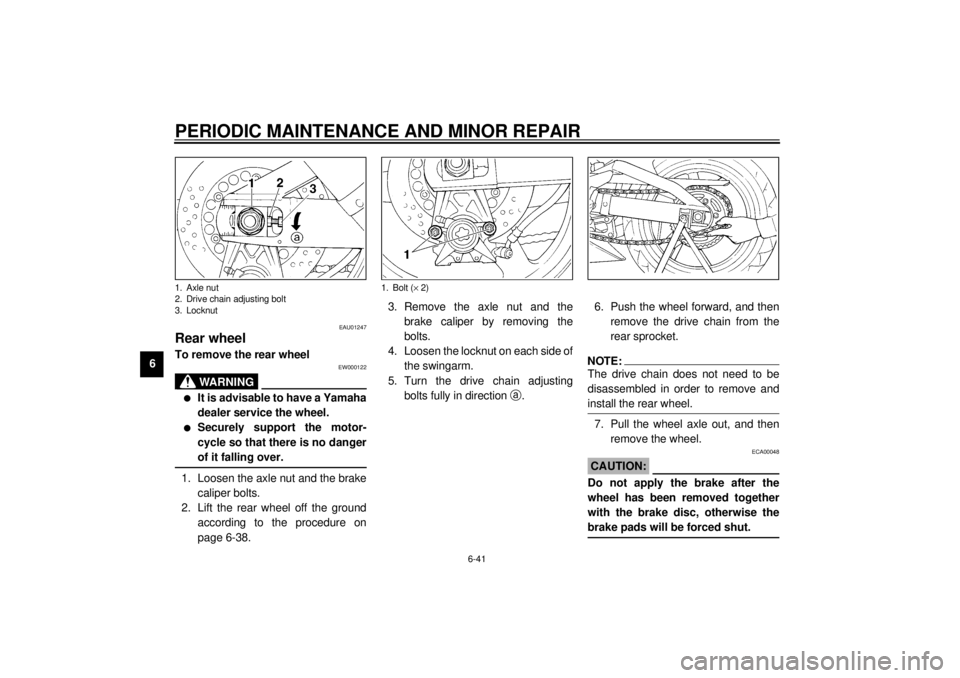
PERIODIC MAINTENANCE AND MINOR REPAIR
6-41
6
EAU01247
Rear wheelTo remove the rear wheel
EW000122
WARNING
@ l
It is advisable to have a Yamaha
dealer service the wheel.
l
Securely support the motor-
cycle so that there is no danger
of it falling over.
@1. Loosen the axle nut and the brake
caliper bolts.
2. Lift the rear wheel off the ground
according to the procedure on
page 6-38.3. Remove the axle nut and the
brake caliper by removing the
bolts.
4. Loosen the locknut on each side of
the swingarm.
5. Turn the drive chain adjusting
bolts fully in direction
a.6. Push the wheel forward, and then
remove the drive chain from the
rear sprocket.
NOTE:@ The drive chain does not need to be
disassembled in order to remove and
install the rear wheel. @7. Pull the wheel axle out, and then
remove the wheel.
ECA00048
CAUTION:@ Do not apply the brake after the
wheel has been removed together
with the brake disc, otherwise the
brake pads will be forced shut. @
1. Axle nut
2. Drive chain adjusting bolt
3. Locknut
1. Bolt (´ 2)
E_5jj_Periodic.fm Page 41 Wednesday, February 2, 2000 5:18 PM
Page 94 of 115

PERIODIC MAINTENANCE AND MINOR REPAIR
6-43
6
EAU02990
Troubleshooting chartsStarting problems or poor engine performance
EW000125
WARNING
@ Keep away open flames and do not smoke while checking or working on the fuel system. @
Check the fuel level in
the fuel tank.1. Fuel
There is enough fuel.
There is no fuel.
Check the compression.
Supply fuel.
The engine does not start.
Check the compression.
Operate the electric starter.2. Compression
There is compression.
There is no compression.
Check the ignition.
Have a Yamaha dealer
check the vehicle.
Remove the spark plugs
and check the electrodes.3. Ignition
Wipe off with a dry cloth and correct the
spark plug gaps, or replace the spark plugs.
Have a Yamaha dealer check the vehicle.
The engine does not start.
Have a Yamaha dealer
check the vehicle.
The engine does not start.
Check the battery.
Operate the electric starter.4. Battery
The engine turns over
quickly.
The engine turns over
slowly.
The battery is good.Check the battery lead connections,
and charge the battery if necessary.
DryWet
Open the throttle halfway and operate
the electric starter.
E_5jj_Periodic.fm Page 43 Wednesday, February 2, 2000 5:18 PM
Page 95 of 115
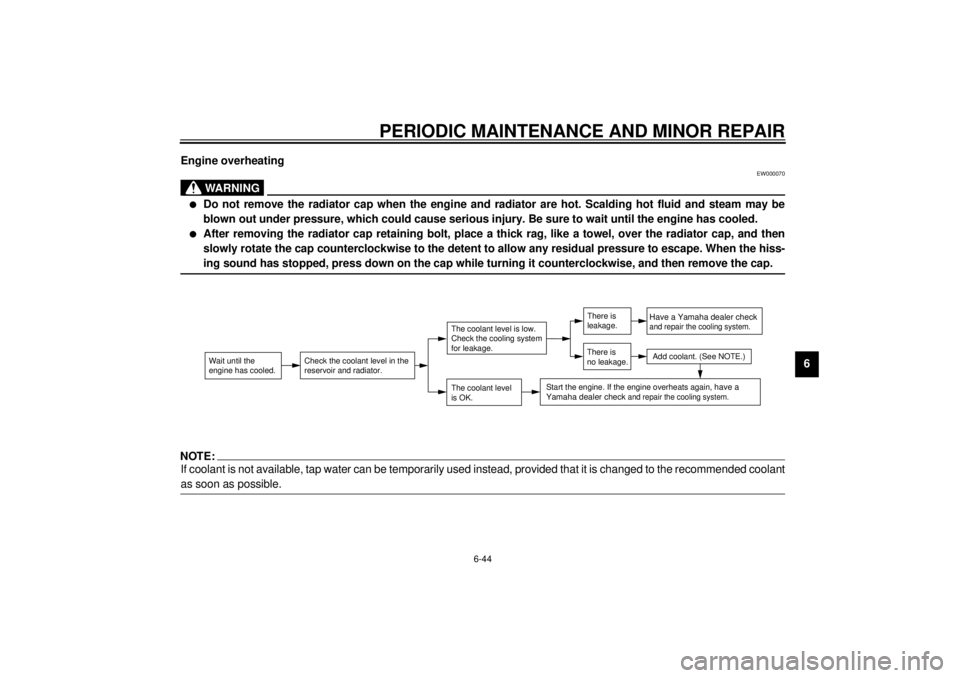
PERIODIC MAINTENANCE AND MINOR REPAIR
6-44
6 Engine overheating
EW000070
WARNING
@ l
Do not remove the radiator cap when the engine and radiator are hot. Scalding hot fluid and steam may be
blown out under pressure, which could cause serious injury. Be sure to wait until the engine has cooled.
l
After removing the radiator cap retaining bolt, place a thick rag, like a towel, over the radiator cap, and then
slowly rotate the cap counterclockwise to the detent to allow any residual pressure to escape. When the hiss-
ing sound has stopped, press down on the cap while turning it counterclockwise, and then remove the cap.
@NOTE:@ If coolant is not available, tap water can be temporarily used instead, provided that it is changed to the recommended coolant
as soon as possible. @
Wait until the
engine has cooled.
Check the coolant level in the
reservoir and radiator.
The coolant level
is OK.The coolant level is low.
Check the cooling system
for leakage.
Have a Yamaha dealer checkand repair the cooling system.Add coolant. (See NOTE.)
Start the engine. If the engine overheats again,
have a
Yamaha dealer check
and repair the cooling system.
There is
leakage.
There is
no leakage.
E_5jj_Periodic.fm Page 44 Wednesday, February 2, 2000 5:18 PM
Page 100 of 115
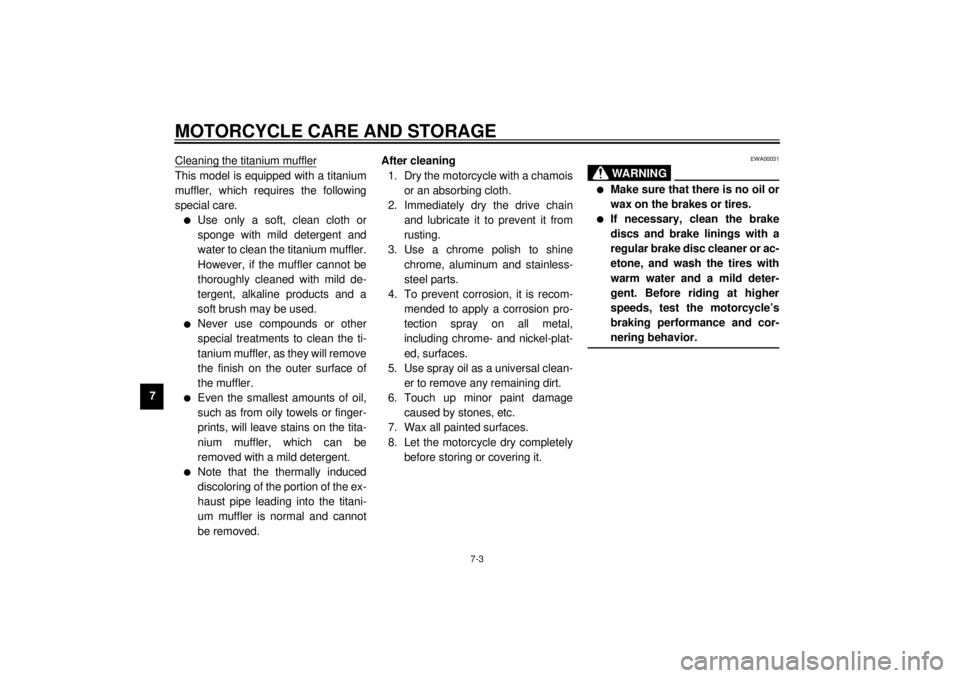
MOTORCYCLE CARE AND STORAGE
7-3
7Cleaning the titanium muffler
This model is equipped with a titanium
muffler, which requires the following
special care.l
Use only a soft, clean cloth or
sponge with mild detergent and
water to clean the titanium muffler.
However, if the muffler cannot be
thoroughly cleaned with mild de-
tergent, alkaline products and a
soft brush may be used.
l
Never use compounds or other
special treatments to clean the ti-
tanium muffler, as they will remove
the finish on the outer surface of
the muffler.
l
Even the smallest amounts of oil,
such as from oily towels or finger-
prints, will leave stains on the tita-
nium muffler, which can be
removed with a mild detergent.
l
Note that the thermally induced
discoloring of the portion of the ex-
haust pipe leading into the titani-
um muffler is normal and cannot
be removed.After cleaning
1. Dry the motorcycle with a chamois
or an absorbing cloth.
2. Immediately dry the drive chain
and lubricate it to prevent it from
rusting.
3. Use a chrome polish to shine
chrome, aluminum and stainless-
steel parts.
4. To prevent corrosion, it is recom-
mended to apply a corrosion pro-
tection spray on all metal,
including chrome- and nickel-plat-
ed, surfaces.
5. Use spray oil as a universal clean-
er to remove any remaining dirt.
6. Touch up minor paint damage
caused by stones, etc.
7. Wax all painted surfaces.
8. Let the motorcycle dry completely
before storing or covering it.
EWA00031
WARNING
@ l
Make sure that there is no oil or
wax on the brakes or tires.
l
If necessary, clean the brake
discs and brake linings with a
regular brake disc cleaner or ac-
etone, and wash the tires with
warm water and a mild deter-
gent. Before riding at higher
speeds, test the motorcycle’s
braking performance and cor-
nering behavior.
@
E_5jj_Cleaning.fm Page 3 Wednesday, February 2, 2000 5:19 PM
Page 102 of 115

MOTORCYCLE CARE AND STORAGE
7-5
7a. Remove the spark plug caps and
spark plugs.
b. Pour a teaspoonful of engine oil
into each spark plug bore.
c. Install the spark plug caps onto the
spark plugs, and then place the
spark plugs on the cylinder head
so that the electrodes are ground-
ed. (This will limit sparking during
the next step.)
d. Turn the engine over several times
with the starter. (This will coat the
cylinder walls with oil.)
e. Remove the spark plug caps from
the spark plugs, and then install
the spark plugs and the spark plug
caps.
EWA00003
WARNING
@ To prevent damage or injury from
sparking, make sure to ground the
spark plug electrodes while turning
the engine over. @
6. Lubricate all control cables and
the pivoting points of all levers and
pedals as well as of the sidestand/
centerstand.
7. Check and, if necessary, correct
the tire air pressure, and then lift
the motorcycle so that both of its
wheels are off the ground. Alterna-
tively, turn the wheels a little every
month in order to prevent the tires
from becoming degraded in one
spot.
8. Cover the muffler outlet with a
plastic bag to prevent moisture
from entering it.9. Remove the battery and fully
charge it. Store it in a cool, dry
place and charge it once a month.
Do not store the battery in an ex-
cessively cold or warm place (less
than 0 °C or more than 30 °C). For
more information on storing the
battery, see page 6-33.
NOTE:@ Make any necessary repairs before
storing the motorcycle. @
E_5jj_Cleaning.fm Page 5 Wednesday, February 2, 2000 5:19 PM
Page 107 of 115

SPECIFICATIONS
8-4
8
Bulb voltage, wattage ´ quantity
Headlight 12 V, 60/55 W ´ 2
Tail/brake light 12 V, 5/21 W ´ 2
Turn signal light 12 V, 21 W ´ 4
Auxiliary light 12 V, 5 W ´ 2
Neutral indicator light LED
High beam indicator light LED
Turn signal indicator light LED
Fuel level warning light LED
Oil level warning light LED
Fuses
Main fuse 30 A
Headlight fuse 20 A
Signaling system fuse 20 A
Radiator fan fuse 10 A
Ignition fuse 15 A
Odometer fuse 10 A
E_5jj_Spec.fm Page 4 Wednesday, February 2, 2000 5:19 PM
Page 112 of 115

10-INDEXAAir filter element, cleaning ...................... 6-15
Anti-theft alarm (optional) .........................3-8BBattery ................................................... 6-33
Brake and clutch levers, checking and
lubricating ............................................ 6-30
Brake fluid, changing ............................. 6-26
Brake fluid level, checking...................... 6-25
Brake lever............................................. 3-11
Brake pedal............................................ 3-11
Brake pedal, lubricating.......................... 6-30
Brake pedal position, adjusting .............. 6-23CCables, checking and lubricating............ 6-29
Carburetors, adjusting............................ 6-17
Care.........................................................7-1
Clutch lever ............................................ 3-10
Clutch lever free play, adjusting ............. 6-22
Controls and instruments .........................2-3
Conversion table ......................................8-5
Coolant .................................................. 6-11
Changing .......................................... 6-13
Checking .......................................... 6-11
Cowlings and panels, removing and
installing ................................................6-5DDrive chain, lubricating ........................... 6-28
Drive chain slack .................................... 6-27
Adjusting .......................................... 6-27
Checking .......................................... 6-27
EEngine break-in ....................................... 5-4
Engine idling speed ............................... 6-17
Engine oil and oil filter cartridge ............... 6-8
Engine, starting a cold ............................. 5-1
Engine, starting a warm ........................... 5-3
EXUP system ........................................ 3-22FFront and rear brake pads, checking ..... 6-24
Front and rear suspension settings ........ 3-21
Front fork, adjusting ............................... 3-16
Front fork, checking ............................... 6-31
Front wheel ........................................... 6-39
Installing........................................... 6-40
Removing......................................... 6-39
Fuel ....................................................... 3-12
Fuel consumption, tips for reducing ......... 5-4
Fuel tank breather hose ......................... 3-13
Fuel tank cap ......................................... 3-11
Fuses, replacing .................................... 6-34HHandlebar switches ................................. 3-9
Dimmer switch ................................... 3-9
Engine stop switch ............................. 3-9
Horn switch ........................................ 3-9
Light switch ........................................ 3-9
Pass switch ........................................ 3-9
Start switch ...................................... 3-10
Turn signal switch .............................. 3-9
Headlight bulb, replacing ....................... 6-35
Helmet holders ...................................... 3-15
IIdentification numbers ..............................9-1
Ignition circuit cut-off system ..................3-23
Indicator lights ..........................................3-2
Coolant temperature warning light ......3-3
Fuel level warning light .......................3-2
High beam indicator light ....................3-2
Neutral indicator light ..........................3-2
Oil level warning light ..........................3-3
Turn signal indicator light ....................3-2KKey identification number .........................9-1LLeft view...................................................2-1
Luggage strap holders ...........................3-22MMain switch/steering lock .........................3-1
Model label ..............................................9-2
Motorcycle, supporting ...........................6-38OOwner’s tool kit ........................................6-1PParking.....................................................5-5
Periodic maintenance and lubrication
chart ......................................................6-2
Pre-operation check list ............................4-1
E_5jjIX.fm Page 1 Wednesday, February 2, 2000 5:20 PM